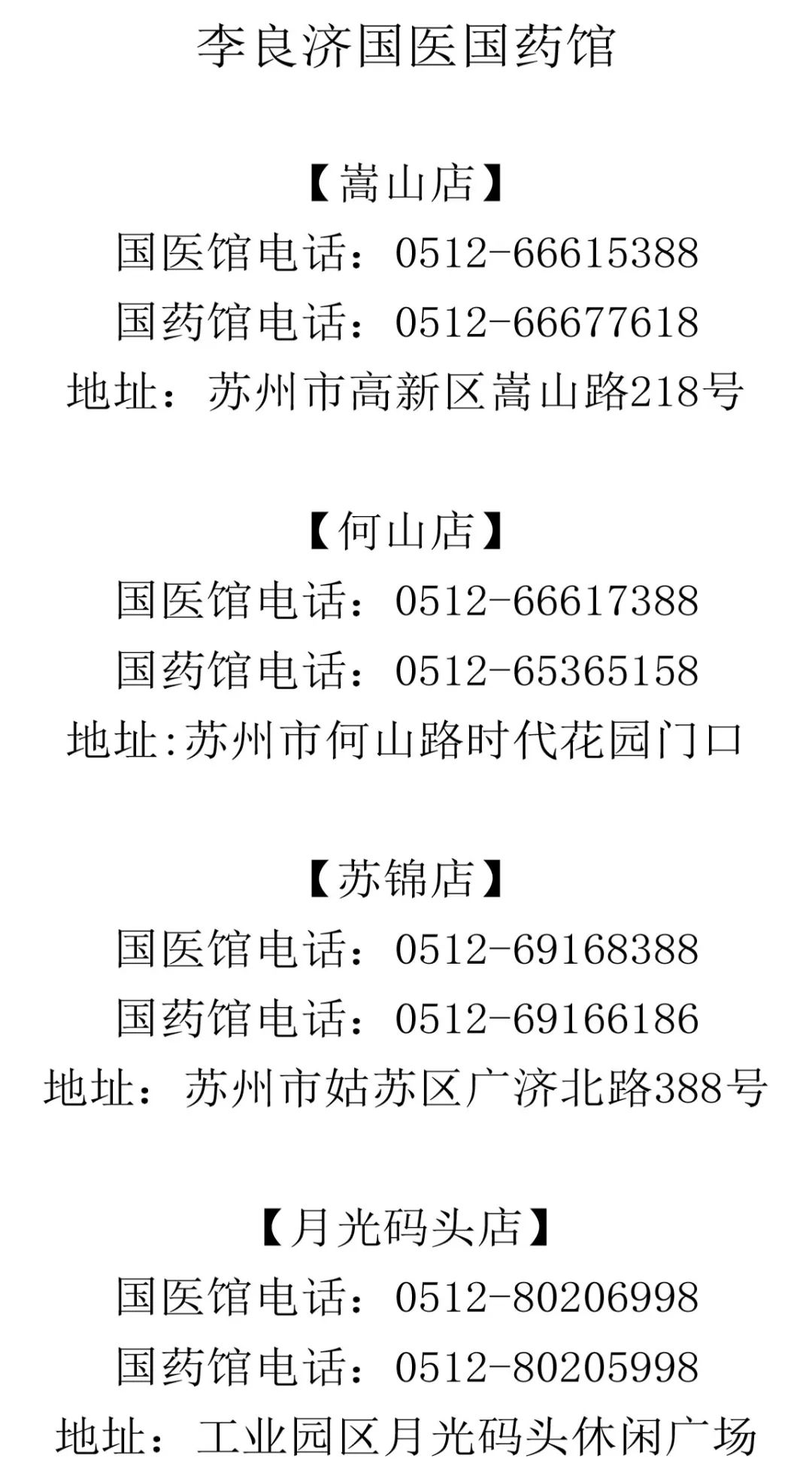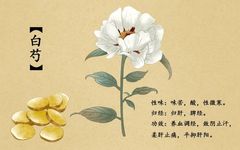▲ Click to enter the official flagship store of Li Liang JiPeony flowers are large and colorful, beautiful and pleasing to the eye, yet they have always been overshadowed by the king of flowers, the peony, and have played a supporting role, aptly named:Flower Companion.Bai Shao (White Peony) is a very distinctive flower, and among the myriad of flowers, it is the only one with the character “药” (medicine) in its name, truly living up to its reputation as a remedy in the hands of healers.Bai Shao (白芍) (“Shennong’s Herbal Classic”)【Properties】Bitter, sour, slightly cold. Enters the Liver and Spleen meridians.【Functions】Nourishes blood, astringes yin, softens the liver, alleviates pain, and suppresses liver yang.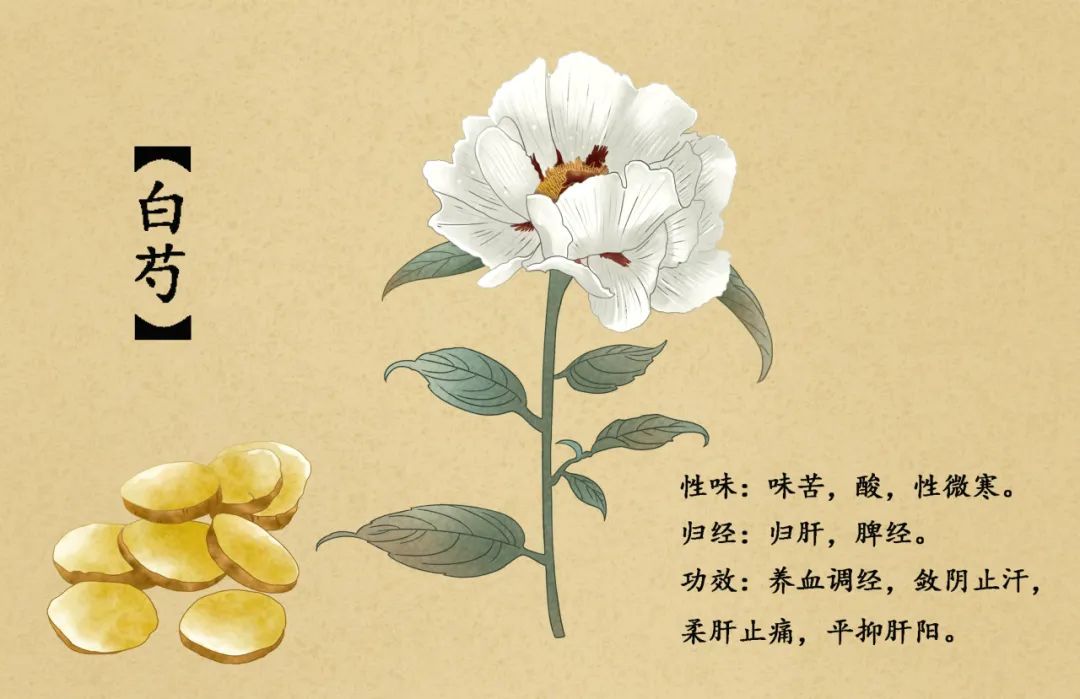 Applications of Bai Shao1. Used for irregular menstruation, abdominal pain during menstruation, metrorrhagia, spontaneous sweating, and night sweats.This herb can nourish blood and regulate menstruation, commonly used in gynecological diseases. For example, the basic formula for regulating menstruation, Si Wu Tang (四物汤), consists of Bai Shao combined with Dang Gui (当归), Chuan Xiong (川芎), and Shu Di Huang (熟地). It can also astringe yin and stop sweating; when combined with Gui Zhi (桂枝), Gan Cao (甘草), Sheng Jiang (生姜), and Da Zao (大枣), it forms Gui Zhi Tang (桂枝汤), which harmonizes the Ying and Wei, treating exterior wind-cold and spontaneous sweating due to deficiency; when combined with Mu Li (牡蛎), Long Gu (龙骨), and Bai Zi Ren (柏子仁), it can astringe yin and stop sweating, treating night sweats caused by yin deficiency and yang floating.
Applications of Bai Shao1. Used for irregular menstruation, abdominal pain during menstruation, metrorrhagia, spontaneous sweating, and night sweats.This herb can nourish blood and regulate menstruation, commonly used in gynecological diseases. For example, the basic formula for regulating menstruation, Si Wu Tang (四物汤), consists of Bai Shao combined with Dang Gui (当归), Chuan Xiong (川芎), and Shu Di Huang (熟地). It can also astringe yin and stop sweating; when combined with Gui Zhi (桂枝), Gan Cao (甘草), Sheng Jiang (生姜), and Da Zao (大枣), it forms Gui Zhi Tang (桂枝汤), which harmonizes the Ying and Wei, treating exterior wind-cold and spontaneous sweating due to deficiency; when combined with Mu Li (牡蛎), Long Gu (龙骨), and Bai Zi Ren (柏子仁), it can astringe yin and stop sweating, treating night sweats caused by yin deficiency and yang floating.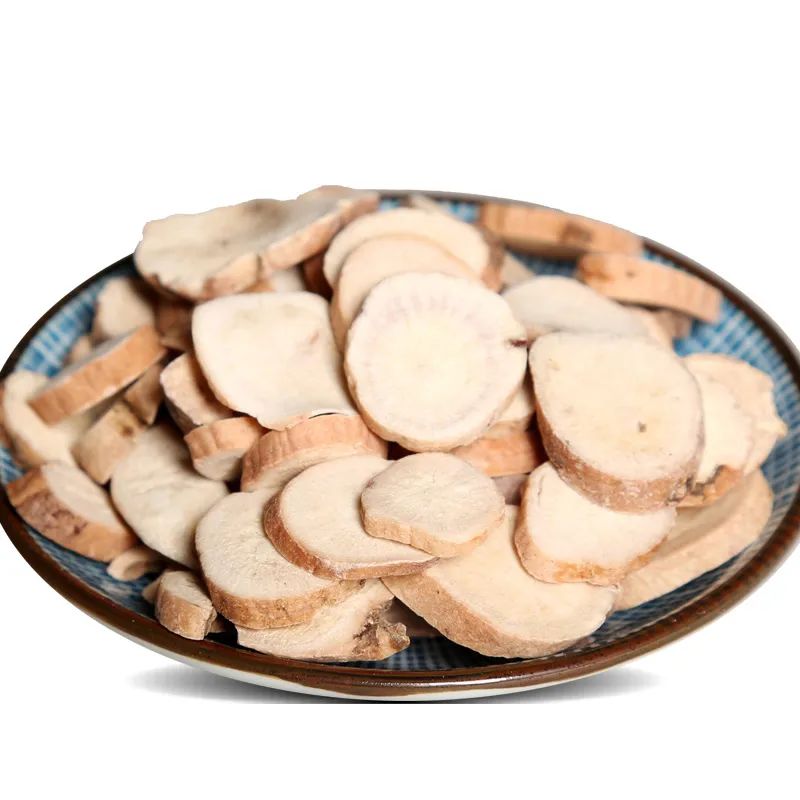 2. Used for disharmony of liver qi, pain in the hypochondrium and abdomen, or pain and stiffness in the limbs.This herb can nourish blood and soften the liver, alleviating pain. For example, Xiao Yao San (逍遥散) combines this herb with Dang Gui, Bai Zhu (白术), and Chai Hu (柴胡) to treat blood deficiency and liver stagnation, resulting in hypochondriac pain; Bai Shao Gan Cao Tang (芍药甘草汤) uses this herb with Gan Cao to treat disharmony between the liver and spleen, abdominal pain due to spasms, and limb pain caused by blood deficiency; Tong Xie Yao Fang (痛泻要方) combines this herb with Fang Feng (防风), Bai Zhu, and Chen Pi (陈皮) to treat abdominal pain and diarrhea; Bai Shao Tang (芍药汤) combines this herb with Mu Xiang (木香), Bing Lang (槟榔), and Huang Lian (黄连) to treat dysentery and abdominal pain.3. Used for liver yang hyperactivity, headache, and dizziness.This herb can suppress liver yang. It is often combined with Sheng Di (生地), Niu Xi (牛膝), and Dai Zhe Shi (代赭石) to treat headaches and dizziness caused by liver yang hyperactivity, such as in Jian Ling Tang (建瓴汤).[Dosage] 10-15g; high dosage 15-30g.【Cautions】Not suitable for use alone in cases of yang deficiency and cold. Avoid with Li Lu (反藜芦).Bai Shao vs. Chi Shao (Red Peony)In the Song Dynasty, the scholar Shen Zuo Zhe had a Q&A about peonies in “Yu Jian”.The question was: People love to admire flowers and view peonies, but I want to ask, is there a difference in the roots of peonies, red and white, in terms of variety?The answer was: Bai Shao receives the qi of supreme yang, thus it is white and good for tonifying; physicians use it to generate blood and alleviate pain; Chi Shao receives incomplete yang qi, thus it is red and good for purging, with different functions, which is a natural principle.
2. Used for disharmony of liver qi, pain in the hypochondrium and abdomen, or pain and stiffness in the limbs.This herb can nourish blood and soften the liver, alleviating pain. For example, Xiao Yao San (逍遥散) combines this herb with Dang Gui, Bai Zhu (白术), and Chai Hu (柴胡) to treat blood deficiency and liver stagnation, resulting in hypochondriac pain; Bai Shao Gan Cao Tang (芍药甘草汤) uses this herb with Gan Cao to treat disharmony between the liver and spleen, abdominal pain due to spasms, and limb pain caused by blood deficiency; Tong Xie Yao Fang (痛泻要方) combines this herb with Fang Feng (防风), Bai Zhu, and Chen Pi (陈皮) to treat abdominal pain and diarrhea; Bai Shao Tang (芍药汤) combines this herb with Mu Xiang (木香), Bing Lang (槟榔), and Huang Lian (黄连) to treat dysentery and abdominal pain.3. Used for liver yang hyperactivity, headache, and dizziness.This herb can suppress liver yang. It is often combined with Sheng Di (生地), Niu Xi (牛膝), and Dai Zhe Shi (代赭石) to treat headaches and dizziness caused by liver yang hyperactivity, such as in Jian Ling Tang (建瓴汤).[Dosage] 10-15g; high dosage 15-30g.【Cautions】Not suitable for use alone in cases of yang deficiency and cold. Avoid with Li Lu (反藜芦).Bai Shao vs. Chi Shao (Red Peony)In the Song Dynasty, the scholar Shen Zuo Zhe had a Q&A about peonies in “Yu Jian”.The question was: People love to admire flowers and view peonies, but I want to ask, is there a difference in the roots of peonies, red and white, in terms of variety?The answer was: Bai Shao receives the qi of supreme yang, thus it is white and good for tonifying; physicians use it to generate blood and alleviate pain; Chi Shao receives incomplete yang qi, thus it is red and good for purging, with different functions, which is a natural principle.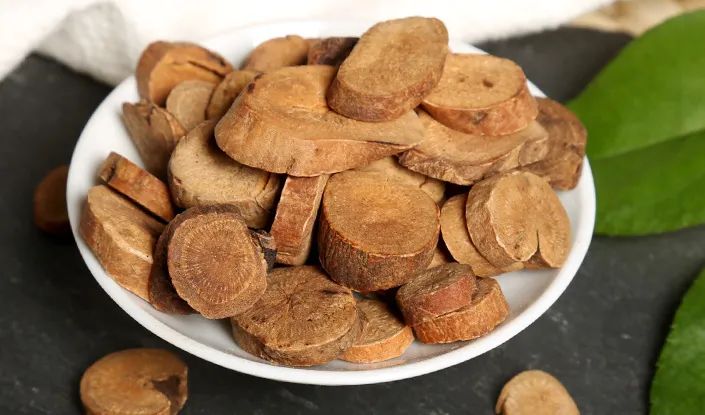 【Differentiation of Medicinal Use】Bai Shao and Chi Shao are not differentiated in “Shennong’s Herbal Classic”, both referred to as Shao Yao (芍药). It was not until the late Tang and early Song dynasties that the two were distinguished. Both have slightly cold properties, but the ancients said, “Bai supplements, Chi purges; Bai astringes, Chi disperses,” which succinctly describes their main differences.Generally, Bai Shao is better at nourishing blood, regulating menstruation, astringing yin, and suppressing liver yang; Chi Shao excels at clearing heat, cooling blood, invigorating blood, and dispelling stasis.In terms of application, Bai Shao is indicated for symptoms of yin and blood deficiency, and hyperactive liver yang; Chi Shao is indicated for symptoms caused by blood heat, blood stasis, and liver fire. Both Bai Shao and Chi Shao can alleviate pain and can be used to treat pain.However, Bai Shao is better at nourishing blood, softening the liver, and alleviating pain, primarily treating hypochondriac pain, abdominal pain, and limb pain caused by liver yin deficiency and blood deficiency; while Chi Shao is better at invigorating blood, dispelling stasis, and alleviating pain, primarily treating pain due to blood stasis, and is particularly suitable for blood heat and stasis.Preparation Methods for Bai Shao1. Bai Shao, take the raw herb, remove impurities, separate into small pieces, wash clean, soak until semi-transparent, take out, moisten until fully transparent, slice thinly, and dry.2. Jiu Bai Shao (Wine-processed Bai Shao), take Bai Shao slices, mix with yellow wine, slightly moisten, wait until the wine is absorbed, then place in a frying container, heat gently until the surface is slightly yellow, take out and cool.For every 100kg of Bai Shao slices, use 10kg of yellow wine.3. Chao Bai Shao (Fried Bai Shao), take Bai Shao slices, place in a frying container, heat gently until the surface is slightly yellow, take out and cool.
【Differentiation of Medicinal Use】Bai Shao and Chi Shao are not differentiated in “Shennong’s Herbal Classic”, both referred to as Shao Yao (芍药). It was not until the late Tang and early Song dynasties that the two were distinguished. Both have slightly cold properties, but the ancients said, “Bai supplements, Chi purges; Bai astringes, Chi disperses,” which succinctly describes their main differences.Generally, Bai Shao is better at nourishing blood, regulating menstruation, astringing yin, and suppressing liver yang; Chi Shao excels at clearing heat, cooling blood, invigorating blood, and dispelling stasis.In terms of application, Bai Shao is indicated for symptoms of yin and blood deficiency, and hyperactive liver yang; Chi Shao is indicated for symptoms caused by blood heat, blood stasis, and liver fire. Both Bai Shao and Chi Shao can alleviate pain and can be used to treat pain.However, Bai Shao is better at nourishing blood, softening the liver, and alleviating pain, primarily treating hypochondriac pain, abdominal pain, and limb pain caused by liver yin deficiency and blood deficiency; while Chi Shao is better at invigorating blood, dispelling stasis, and alleviating pain, primarily treating pain due to blood stasis, and is particularly suitable for blood heat and stasis.Preparation Methods for Bai Shao1. Bai Shao, take the raw herb, remove impurities, separate into small pieces, wash clean, soak until semi-transparent, take out, moisten until fully transparent, slice thinly, and dry.2. Jiu Bai Shao (Wine-processed Bai Shao), take Bai Shao slices, mix with yellow wine, slightly moisten, wait until the wine is absorbed, then place in a frying container, heat gently until the surface is slightly yellow, take out and cool.For every 100kg of Bai Shao slices, use 10kg of yellow wine.3. Chao Bai Shao (Fried Bai Shao), take Bai Shao slices, place in a frying container, heat gently until the surface is slightly yellow, take out and cool.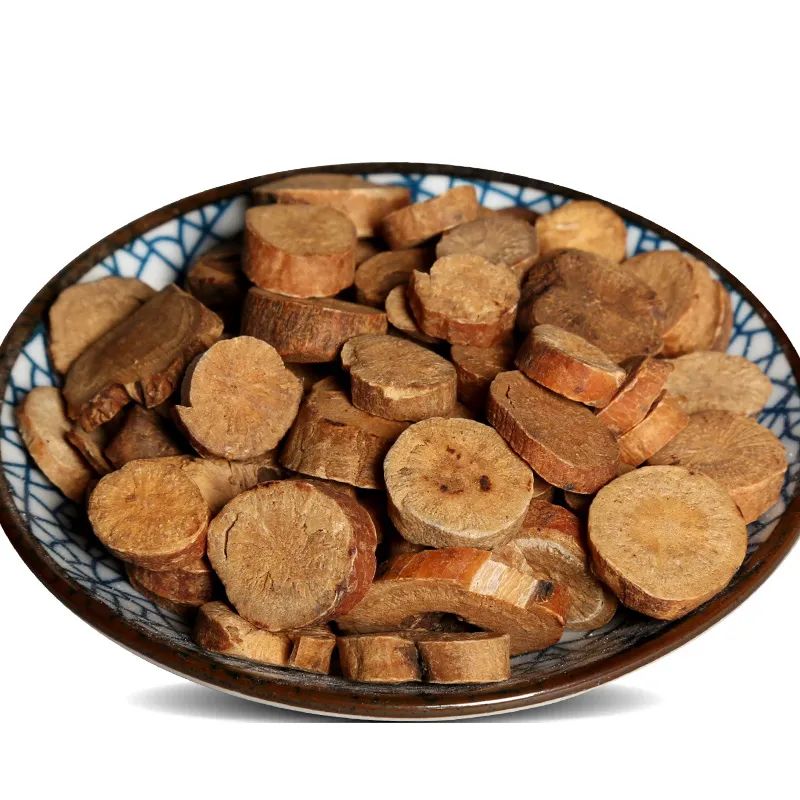 【Effects of Preparation】Bai Shao, has a bitter, sour taste and a slightly cold nature. It enters the Liver and Spleen meridians. It has the functions of nourishing blood, regulating menstruation, astringing yin, stopping sweating, softening the liver, and alleviating pain.It is commonly used for blood deficiency, pale complexion, irregular menstruation, spontaneous sweating, night sweats, hypochondriac pain, abdominal pain, limb pain, headache, and dizziness.For example, to treat liver yang hyperactivity, headache, and dizziness, Jian Ling Tang (建瓴汤) (“Records of the West”) is used; to treat accumulated heat not dispersing, red and swollen eyes, or the formation of cataracts, Xie Gan Tang (泻肝汤) (“Complete Records”); to treat yin deficiency and fever, Shao Yao San (芍药散) (“Universal Formulas”); to treat postpartum deficiency and insomnia, Shao Yao Zhi Chi Tang (芍药栀豉汤) (“Jiyin”).
【Effects of Preparation】Bai Shao, has a bitter, sour taste and a slightly cold nature. It enters the Liver and Spleen meridians. It has the functions of nourishing blood, regulating menstruation, astringing yin, stopping sweating, softening the liver, and alleviating pain.It is commonly used for blood deficiency, pale complexion, irregular menstruation, spontaneous sweating, night sweats, hypochondriac pain, abdominal pain, limb pain, headache, and dizziness.For example, to treat liver yang hyperactivity, headache, and dizziness, Jian Ling Tang (建瓴汤) (“Records of the West”) is used; to treat accumulated heat not dispersing, red and swollen eyes, or the formation of cataracts, Xie Gan Tang (泻肝汤) (“Complete Records”); to treat yin deficiency and fever, Shao Yao San (芍药散) (“Universal Formulas”); to treat postpartum deficiency and insomnia, Shao Yao Zhi Chi Tang (芍药栀豉汤) (“Jiyin”). Chao Bai Shao, with its cold nature moderated, primarily nourishes blood and harmonizes the Ying, astringes yin and stops sweating. It is used for blood deficiency, pale complexion, abdominal pain, diarrhea, spontaneous sweating, and night sweats. For example, to treat abdominal pain and diarrhea due to liver excess and spleen deficiency, Tong Xie Yao Fang (痛泻要方) (“Jing Yue”); to treat chronic dysentery with abdominal pain that prefers pressure and warmth, Yang Zang Tang (养脏汤) (“Jufu”); to treat deficiency and spontaneous sweating that does not stop, Shao Yao Huang Qi Tang (芍药黄芪汤) (“Zhu Shui Xuan Pearl”); to treat blood in stool due to alcohol toxicity, Shao Yao Wan (芍药丸) (“Zhu’s Collection of Verified Formulas”).Jiu Bai Shao, with its sour and cold nature reduced, enters the blood aspect, is good at regulating menstruation and stopping bleeding, and is used for liver stagnation and blood deficiency, hypochondriac pain, abdominal pain, irregular menstruation, and limb pain. For example, to treat blood collapse and abdominal pain, Liu Yi San (六一散) (“One Plate Pearl”); to treat women’s blood injury with red and white discharge, Shao Yao Jiu Jiu Fang (芍药浸酒方) (“Universal Formulas”); to treat marrow deficiency and cold, pain, and fatigue, Shao Yao Hu Gu San (芍药虎骨散) (“Complete Records”).Beauty through Qi and Blood NourishmentWhen it comes to nourishing blood, we must mention beauty.Blood is the foundation of health and beauty in the human body. Those with blood deficiency often have a yellow or pale complexion, dull lips, and lack of luster in their nails, making it difficult to achieve a rosy and radiant complexion.
Chao Bai Shao, with its cold nature moderated, primarily nourishes blood and harmonizes the Ying, astringes yin and stops sweating. It is used for blood deficiency, pale complexion, abdominal pain, diarrhea, spontaneous sweating, and night sweats. For example, to treat abdominal pain and diarrhea due to liver excess and spleen deficiency, Tong Xie Yao Fang (痛泻要方) (“Jing Yue”); to treat chronic dysentery with abdominal pain that prefers pressure and warmth, Yang Zang Tang (养脏汤) (“Jufu”); to treat deficiency and spontaneous sweating that does not stop, Shao Yao Huang Qi Tang (芍药黄芪汤) (“Zhu Shui Xuan Pearl”); to treat blood in stool due to alcohol toxicity, Shao Yao Wan (芍药丸) (“Zhu’s Collection of Verified Formulas”).Jiu Bai Shao, with its sour and cold nature reduced, enters the blood aspect, is good at regulating menstruation and stopping bleeding, and is used for liver stagnation and blood deficiency, hypochondriac pain, abdominal pain, irregular menstruation, and limb pain. For example, to treat blood collapse and abdominal pain, Liu Yi San (六一散) (“One Plate Pearl”); to treat women’s blood injury with red and white discharge, Shao Yao Jiu Jiu Fang (芍药浸酒方) (“Universal Formulas”); to treat marrow deficiency and cold, pain, and fatigue, Shao Yao Hu Gu San (芍药虎骨散) (“Complete Records”).Beauty through Qi and Blood NourishmentWhen it comes to nourishing blood, we must mention beauty.Blood is the foundation of health and beauty in the human body. Those with blood deficiency often have a yellow or pale complexion, dull lips, and lack of luster in their nails, making it difficult to achieve a rosy and radiant complexion.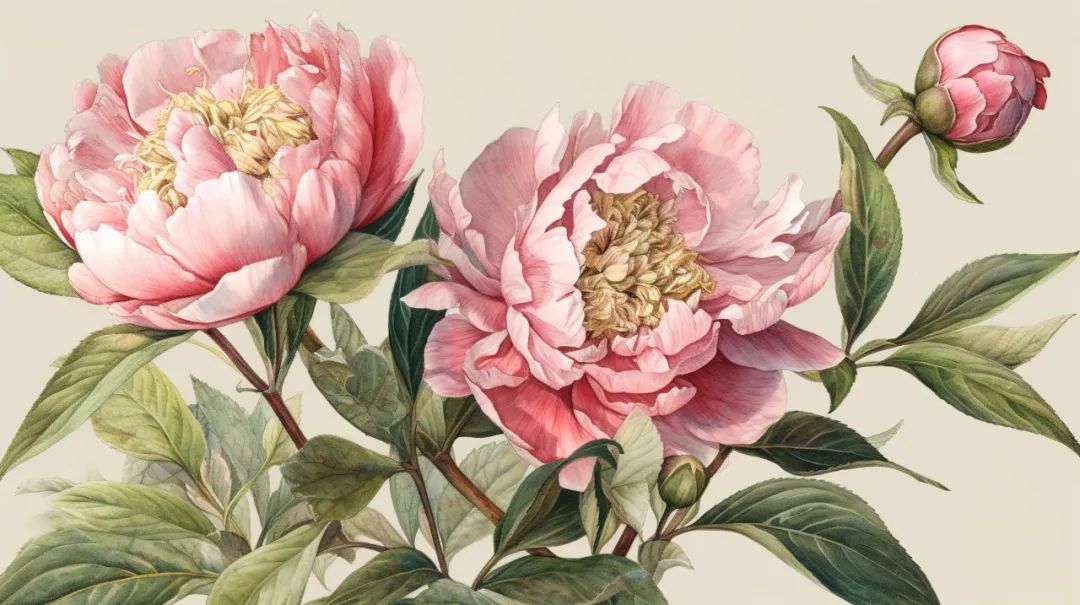 In TCM blood-nourishing formulas, Bai Shao is often used, such as the well-known Si Wu Tang (四物汤) in “Taiping Huimin Heji Ju Fang”, which combines Bai Shao with Shu Di Huang, Dang Gui, and Chuan Xiong to nourish blood and regulate menstruation.At home, one can take 12g of Shu Di, 9g of Bai Shao, 6g of Dang Gui, 6g of Chuan Xiong, add 3 red dates, and boil in water for 1 hour to drink as tea for beauty and skin health.The Ming Dynasty medical text “Yixue Rumeng” records a formula called San Bai Tang (三白汤), which consists of Bai Shao, Bai Zhu, Bai Fu Ling, and Gan Cao, boiled in water and taken warm.This formula is used to treat febrile disorders and deficiency, and later discovered to nourish qi and blood, whiten and moisturize the skin, used for beauty and health. Bai Shao has a sweet and sour taste, slightly cold nature, and has blood-nourishing effects, and when used in combination with Bai Zhu and Fu Ling, it has a whitening effect.
In TCM blood-nourishing formulas, Bai Shao is often used, such as the well-known Si Wu Tang (四物汤) in “Taiping Huimin Heji Ju Fang”, which combines Bai Shao with Shu Di Huang, Dang Gui, and Chuan Xiong to nourish blood and regulate menstruation.At home, one can take 12g of Shu Di, 9g of Bai Shao, 6g of Dang Gui, 6g of Chuan Xiong, add 3 red dates, and boil in water for 1 hour to drink as tea for beauty and skin health.The Ming Dynasty medical text “Yixue Rumeng” records a formula called San Bai Tang (三白汤), which consists of Bai Shao, Bai Zhu, Bai Fu Ling, and Gan Cao, boiled in water and taken warm.This formula is used to treat febrile disorders and deficiency, and later discovered to nourish qi and blood, whiten and moisturize the skin, used for beauty and health. Bai Shao has a sweet and sour taste, slightly cold nature, and has blood-nourishing effects, and when used in combination with Bai Zhu and Fu Ling, it has a whitening effect.
END
For more health products, you can visit the official flagship store to purchase.Disclaimer:This article is compiled from the internet for learning and reference purposes only and cannot replace medical advice and prescriptions. Please use under the guidance of a physician. The sharing aims to disseminate health science knowledge, and any objections will be deleted.Tips:If you have any questions, you can add Li Liang Ji health consultant (Liang Ji Jun) on WeChat, send us your questions, and we will reply to you as soon as possible to help you!
